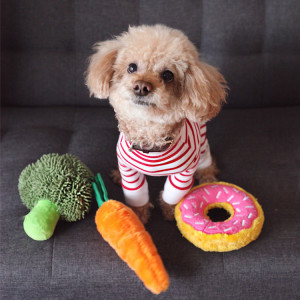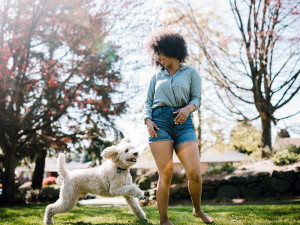Why Do Dogs Chase Trucks?
Why do some dogs seem to lose their minds when a truck goes by?

share article

Your pet wants you to read our newsletter. (Then give them a treat.)
Some may think that a dog’s natural nemesis is the cat. Incorrect. A dog’s number one enemy is the garbage truck. Even dogs who are chill with cars and pick-ups lose it when a garbage truck goes by — it’s even more offensive when the thing stops to collect the trash in front of their house! Why are dog’s freaking out over this particular vehicle, and what can we do about it?
Not every dog who sees a hulking, noisy garbage truck will react to them, but many do. If they’re confronted by one while they’re outside, they might even try to chase it, or bark their heads off from the yard. Seeing it while they’re inside the house may set off an attack of frenzied yelping at the window. This can be annoying, but it’s more the danger of the situation that concerns pet parents Here’s what you can do to protect your dog from fighting against an indefeatable foe.
What is it about garbage trucks that upsets dogs?
Pretty much everything. They’re big, they’re loud in a whole bunch of different ways, and they stop and start frequently. Heaven only knows how dogs feel about the variety of smells that emanate from them, but there’s certainly a powerful olfactory component. On top of everything — in towns and cities, at least — they pull up right in front of the dog’s house.
When dogs are afraidopens in a new tab of something, they naturally want to increase the distance between themselves and that something. If a dog runs away and hides, they’re obviously afraid and want to get as far as possible from the source of the fear. Running toward something that scares them may seem counterintuitive. Why not run away from it?
When a dog takes an “I’ll get you before you get me” kind of approach — lungingopens in a new tab, charging, and barking — their goal is to increase the distance by making the other thing go away. Dogs learn that the truck retreats when they chase it or bark at it, so it’s a behavior they continue to engage in because it’s reinforced every time the truck moves on.
If your dog is in the reactiveopens in a new tab group and you want to change the behavior, there are ways to help them dial it back. In order to do that, however, you need to figure out the cause: Is it set off by a desire to chase, or is it fear-based? Some of these techniques are helpful no matter what is behind the behavior.
Is the Response Chase-Based?
If a dog is reacting to the garbage truck for the fun of chasing something, then that desire to run and chase can be part of the solution. Since the sight of the vehicle provokes the behavior, one way to turn the behavior around is to literally turn it around: Get your dog to runopens in a new tab in the other direction by chasing you or, perhaps, a toy. The more fun this alternative chase is for your dog, the easier it will be to train them to turn away from the truck.
Proximity matters. Start by teaching your dog to chase you (or a toy) when there’s no garbage truck in sight. You can do this outside as well as in your house, either by holding the toy and running with it or tossing it. Don’t throw it too far, and if you’re on a sidewalk rather than in a fenced yard, keep your dog on leash for safety’s sake. Repeatedly practicing this strategy will build the foundation necessary to teach them to turn away from the truck.
Once your dog is reliably chasing you or the toy, encourage them to do so when the garbage truck is in the vicinity. As with all training, it’s wise to start with situations that are as easy as possible for your dog. Generally, that means when the truck is far away. For some dogs, it’s not reasonable to expect them to chase you or a toy instead of the truck unless the truck’s at least two blocks away. Only try it with the truck closer when they’re really good at doing it at whatever distance they can already handle; decrease the distance by just a little bit each time — perhaps the length of a single house.
Is the Response Fear-Based?
If the behavior stems from fear, you can change your dog’s emotional response by teaching them to associate the truck with treats. To be successful with this classical counterconditioning technique, details matter. Specifically, it is important that the truck is far enough away from your dog that they are not upset by it. Once they learn to associate the garbage truck at that distance with treats, you can start to give them treats when the truck is a little bit closer, but still far enough away that they’re not scared.
To help them learn not to be afraid of the garbage truck, they must have many experiences with seeing and hearing it, during which they’re not afraid and get treats. That means you’ll need to very, very gradually decrease the distance between them and the truck during training sessions — a process that can take weeks or even months — and always give them treats and make sure they’re comfortable. If they react fearfully, you are too close; remove them from the situation as soon as you can, and try again at a greater distance.
When Your Dog Is Inside
When teaching your dog to move away from the window or door where they can see the truck, start when the truck is at the maximum distance at which they can see or hear it. Having them move away as soon as they detect the truck’s presence will enhance your efforts to teach them to turn away even when the truck rolls up right outside. Until they can do that, it’s advisable to put them in another room where they can’t see the truck with a stuffed toy or something else they enjoy while the truck is passing directly by.
A basic dog-training strategy that can help with this issue is to teach them to perform an incompatible behavior. If your dog is sitting down, running after a tennis ball or looking at you in anticipation of receiving a toy, they can’t simultaneously chase the truck. To use this training method, decide what you want your dog to do instead.
“Anything else would be fine!” isn’t a suitable option, by the way. You need to choose what you would specifically like them to do, then teach them to do it in the problematic context.
For example, teach your dog that if they turn away from the window when they see or hear the garbage truck, they will get something that is valuable to them. Be ready with a toy such as a hollow rubber Kongopens in a new tab stuffed with top-quality, smelly treatsopens in a new tab. These types of toys keep dogs occupied longer — in this case, until the truck has passed. Even a generous handful of loose treats will only last a few seconds, after which the dog will head right back to the window to bark.
As soon as you hear the garbage truck, put the stuffed toy by your dog’s nose, say, “This way,” and lure them to a place where they can no longer see out the window. Then, give them the reward so that they are both reinforcedopens in a new tab for coming away from the window and have something enticing to keep them occupied for a while. Again, be sure to stuff it with really high-quality treats. It will take the smell of something special to outcompete their interest in the garbage truck; so-so treats, dry treats, or kibbleopens in a new tab are unlikely to cut it.
Once they’re reliably and willingly coming away from the window in response to being lured, start cueing them from a few feet away, encouraging them to turn on their own. With practice, you will be able to have them come away from the window without having to lure them.
Eventually, many dogs will get to the point where they notice the garbage truck, then seek out their people in anticipation of the reward they’ve come to expect in that situation.
Manage the Context
Though it may not sound like a satisfying approach, preventing encounters with garbage trucks by avoiding them when possible is an excellent idea. Every time your dog sees a garbage truck and acts in an undesirable way, they’re practicing and being rewarded for a behavior you don’t want them to perform. That is counterproductive to your goal of teaching them to do something else when around these vehicles.
The simple strategy of keeping them on-leash while outside goes a long way toward keeping them out of trouble, as does trying not to cross paths with the garbage truck. Don’t walk in the neighborhood on trash pick-up day, at least not at the time of day when the trucks are roaming the streets.
If, through bad luck or bad timing, you can’t avoid the garbage truck on a particular day, have a plan so that one incident doesn’t contribute to making the problem worse. There are a couple of strategies you can employ.
One is to get them out of the situation as quickly as possible. By increasing the distance between your dog and the garbage truck, you minimize the damage to their progress. So, move away from it, whether that means heading down a side street; making a U-turn and going the other way; or, when inside, moving away from the street-facing side of your home.
Another is to block the truck from your dog’s sight, which may mean pulling down the shades in your house or walking behind a parked vehicle on the street. They’ll still hear the truck, but blocking the visual cues can be helpful.
However you choose to address it, don’t make your dog’s issue with garbage trucks worse by using harsh reprimands or punishment. It goes without saying that we should not punish our dogs. Punishment damages the relationship you have with your dog and it is counterproductive, especially when fear is involved.
With a plan that includes prevention as well as training, you can help your dog handle the monster that we humans refer to as the garbage truck.

Karen B. London, PhD, CAAB, CPDT-KA
Karen B. London, Ph.D., is a Certified Applied Animal Behaviorist and Certified Professional Dog Trainer who specializes in working with dogs with serious behavioral issues, including aggression, and has also trained other animals including cats, birds, snakes, and insects. She writes the animal column for the Arizona Daily Sun and is an Adjunct Professor in the Department of Biological Sciences at Northern Arizona University. She is the author of six books about training and behavior, including her most recent, Treat Everyone Like a Dog: How a Dog Trainer’s World View Can Improve Your Lifeopens in a new tab.
Related articles
![Dog on leash sitting on a colorful street and looking attentive at their pet parent]() opens in a new tab
opens in a new tabYou — Yes, You — Can Get Your Dog to Pay Attention to You
Here are some simple steps to pry your pup away from that one spot in the yard they’re obsessed with.
![smart dog choosing between several toys]() opens in a new tab
opens in a new tabHow to Tell if Your Dog is a Genius
Is your dog the ultimate smarty pants?
![A woman with curly black hair playing with her white labradoodle dog outside]() opens in a new tab
opens in a new tab7 Games That Can Actually Teach Your Dog Something
Cue the Schoolhouse Rock! because learning can be fun.
![Dog barking]() opens in a new tab
opens in a new tabHow to Stop Your Dog From Barking
The top five reasons dogs bark—and how to get them to relax a bit.




